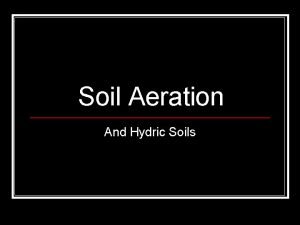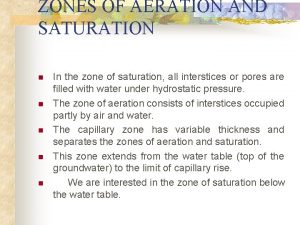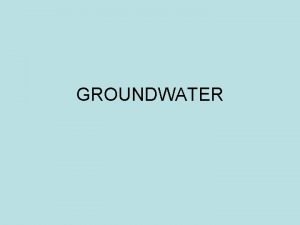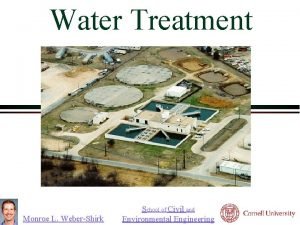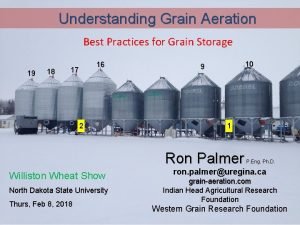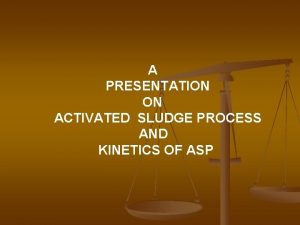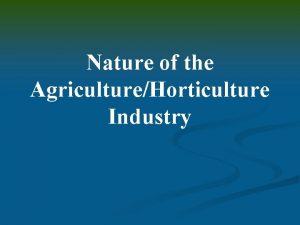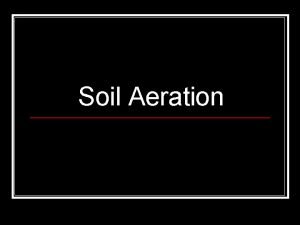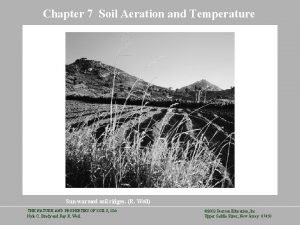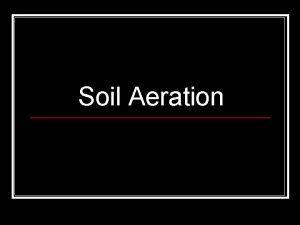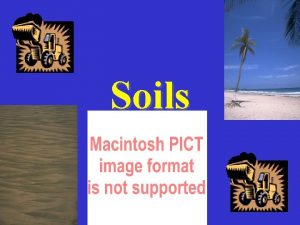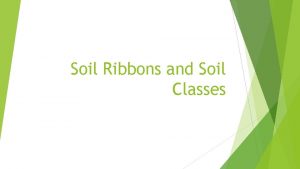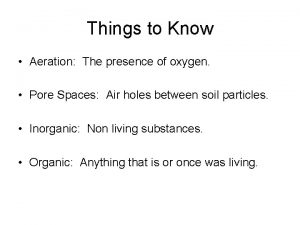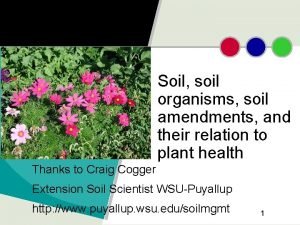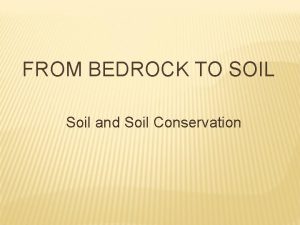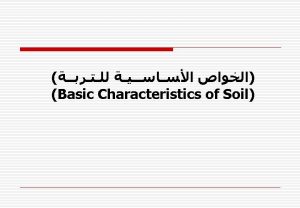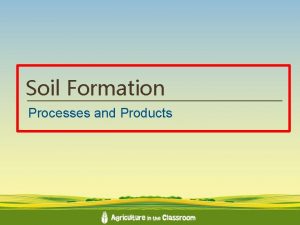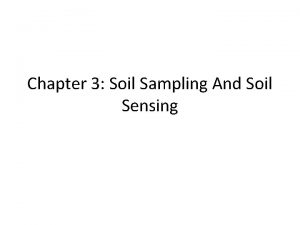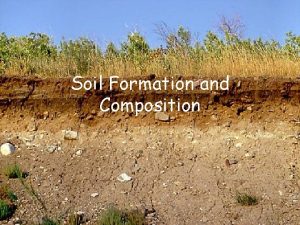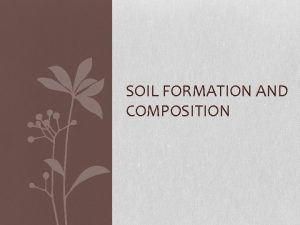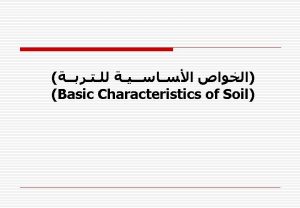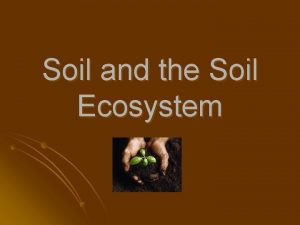Soil and Agriculture Terms to Know Aeration The





























- Slides: 29

Soil and Agriculture

Terms to Know • Aeration: The exchange of air from soil with air from the atmosphere. If soil is not aerated it contains higher levels of carbon monoxide. • Alluvium: Material such as sand, silt, or clay, deposited on land by streams and rivers. • Bedding System: A drainage system made by plowing, grading, or otherwise shaping the surface of a flat field into rows and furrows. • Runoff: The precipitation that is discharged into a stream or rivers. Runoff can contain contaminants such as fertilizer, pesticides, and other chemicals.

Terms to Know • Channery Soil: A soil that is more than 15 percent fragments of sandstone, shale, slate, or limestone. Good for drainage not for plant growth. • Clay: A greasy like soil that is high is moisture content. Soil particles are less than 0. 002 millimeters in diameter. Soil that is 40% or more clay, less that 45% sand less than 40% silt.

Terms to Know • Conservation Tillage: A tillage system that does not invert the soil and that leaves a protective crop on the surface throughout the year. • Drainage: Runoff, or the surface flow of water from an area. • Erosion: The wearing away of the land surface by water, wind, or ice.

Terms to Know • Soil Fertility: The qualities that enable soil to provide plant nutrients in adequate amounts and in proper balance. • Flood Plain: A nearly level plain that boarders a stream and is subject to flooding unless protected artificially. • Gravel: Rounded or angled rock up to 3 inches in diameter. • Ground Water: Water filling all the unblocked pores of material below the water table. • Crop Rotation: Systematically moving crops to different fields to reduce the draining of nutrients and to maximize crop yield.

Terms to Know • Intake Rate: The average rate of water entering the soil using irrigation methods. • Irrigation: Application of water to soils to attempt in crop production. • Organic Matter: Plant and animal residue in the soil in various stages of decomposition. • Silt: Individual mineral particles that are larger than clay but smaller than sand. • Sand: Larger particles of minerals mainly made up of quartz. Must be 85% or more sand no more than 10% clay.

Soil in Agriculture • Like gardening at home, good soil structure is important to Nova Scotian farmers who rely on crops to sell or to feed their livestock. • Soil quality varies from county to county in Nova Scotia which dictates what crops can be grown in given locations. • One crop may be grown well in Lunenburg county but may not grow well in Cape Breton Victoria county all because of soil differences.


Plants and Soil • All plants needs a healthy balance of nourishment to be able to support agricultural methods. • This nourishment is called media. Media can be soil, water, leaf mold, compost, peat moss, etc… • In early agriculture, societies used the soil as it existed. It was not until the Industrial Revolution (late 1700’s until early 1900’s) that fertilization and soil nourishment was understood.

Plants and Soil (continued) • Productive soil for agriculture is created as the atmosphere, sunlight, water, and living things meet and interact with the minerals of the earth. • It takes 3, 000 - 12, 000 years to create a layer of soil sufficient to support agriculture. • These soils need nutrients, water, specific soil makeup, drainage, and sunlight.

Soil Creation • The type of soil is determined by the following six factors. 1) Climate/Location: Temperature, water amounts, and sunlight all alter the type of soil in an area. 2) Living Organisms: Decay of living organisms provide nourishment for soil. 3) Parent Material: The material from which the soil develops. The parent material is the 3 rd layer from the suface.

Soil Creation (continued) 4) Topography: The shape and slope of the land. Affects the distribution of soil particles and water. Example: steep slopes may have valuable soil washed downhill by rain. 5) Time: Soils are formed by the chemical and physical weathering of parent material over time. 6) Weathering: The mechanical forces caused by temperature changes that cause soils to develop, mature, and age.

Soil Grades • 1) 2) 3) Soil is divided into 3 grades based on physical characteristics and the “feel” of that soil. Coarse-texture (sandy) soil: is loose and individual grains can easily be seen and felt. Squeezed in the hand when dry it will fall apart. Squeezed when wet it will hold form but crumble when touched. Medium-textured (loam) soil: has a relatively even mixture of sand, silt, and clay. Squeezed when moist, it will hold form and can be handled freely without breaking. Fine-textured (clay) soil: usually forms hard lumps or clods when dry. Very sticky when wet.

Soil Horizons • Soil is broken down into 5 horizons or layers. • These layers in order are O, A, E, B, and C. • The O horizon is the surface layer and is comprised of organic material and small amounts of minerals. • Horizon A is near the surface and is what supports plant growth. • The E horizon is the leaching zone which allows water to drain. • The B horizon contains minerals like A but has less organic material. This is called subsoil. • The C horizon is mostly made up of parent material and is important for releasing water into the upper layers. This layer does not contribute much to plant nutrition.

Horizon Name Colour Structure Process Occurring O Organic Black, Dark brown Loose, crumbly, well broken up. Decomposition A Topsoil Dark brown to yellow Loose, crumbly, well broken up. Zone of Leaching E Zone of Leaching Gray Porous and loose. Leaching B Subsoil Brown, red, yellow, or gray Larger chunks, crumbly and can be cement like. Zone of Accumulation C Parent Material Variable Dense and well compacted. Weathering of parent material

Soil Structure

Soil and Organic Matter • It is often necessary to add organic materials to soil to prepare it for supporting the growth of plants. • Common sources of organic materials are: peat moss, leaf mold, compost, livestock manure, and sawdust. • Farmers and gardeners will add these organic materials periodically to their soil to give plants a healthy growing environment.

Soil and Organic Material • Here are some of the benefits of organic material in soil: v Makes the soil porous. v Supplies nitrogen and other nutrients to the growing plant. v Holds water for future plant use. v Aids in managing soil moisture content. v Provides food for soil organisms. v Serves as a storehouse for nutrients. v Minimizes leaching. v Serves as a source of nitrogen and growth promoting substance. v Stabilizes soil structure.

Media used for plant growth • Leaf Mold: Partially decomposed leaves and compost (organic matter). Adds nutrients to soil. • Sphagnum Moss: Used in horticulture to promote root and plant growth. • Peat Moss: Great for holding in water and oxygen. • Rotting Wood: (deadfall trees, fence posts, etc. . ) Break down to provide soil with nutrients and moisture. • Manure and Straw: Contains natural nutrients for soil and plants and also helps maintain soil moisture and food for living organisms.

Agriculture Fertilization and Soil • Often soil is not adequate to support the growth of plants without making changes to it. • Most changes include the adding of organic material or changing the p. H levels. • The p. H is a measure of the degree of acidity (sourness) or alkalinity (sweetness). • It is important to know the p. H of the soil as different plants require different acidity levels to achieve maximum growth.

Agricultural Fertilization of Soil • When fields are low or imbalanced with certain nutrients, farmers will often apply fertilizers (both chemical and natural) to that soil. • This fertilizer is often spread in the spring and again in the fall. • Natural fertilizers include: animal manure, sawdust, oyster or mussel shells, fish guts, lime, etc… • Chemical fertilizers include: ammonia, ammonium nitrate, urea, and phosphate.


Soil formation • Soil formation is affected by: Ø Climate Ø Living organisms (in or on the soil) Ø Parent soil material Ø Topography (shape of land) Ø Time • Each factor changes with the local conditions of a given area.

Climate • Temperature and rainfall affect weathering and soil/plant health. • Higher temperatures = faster chemical reactions, faster growth of fungi, bacteria, and plants. • Higher rainfall = leaching of nutrients from soil and acidic soil. • Slope and location of a field affect erosion and drainage which can alter growing conditions.

Living Organisms • Microbes, plants, insects, animals, and humans all influence soil formation. • Some help break down organic matter to add nutrients to soil. • Insects, worms, and animals help mix soil materials. • Construction projects, cultivation, and clear cutting also influence the surface layers of soil and soil formation.

Topography • Slope and drainage affect soil formation. • Erosion on a steep slope moves particles downhill to add them to lower levels and it exposes subsoil materials along upper slopes. • Soils on level land tend to be poorly drained to soils on rolling slopes. • Drainage affects the water table and therefore soil. • Wet soil has little air which slows the action of microbes and fungi that make soil.

Weathering • Weathering is mechanical forces caused by hearing, cooling, freezing, and thawing. • These forces break down rocks, minerals, organic matter, and soil-forming materials. • When nutrients have been leached away or used by plants, soils become acidic and unproductive…. it takes lots of work to make them fertile again.

In conclusion • Soil and soil health is essential to all farmers in Nova Scotia and around the world. • Without nutrient rich soils, the proper climate, weather, and soil formation, agriculture and farming practices will struggle and often fail. • It is a constant battle for farmers to find this healthy balance so their soil yields the crops needed to make agriculture viable.

End of Section Questions 1) 2) 3) 4) 5) 6) 7) List and explain the six factors used to determine soil types. Name and explain the three soil grades. Name and explain the five soil horizons. What are the benefits of organic material in soil? Name at least five. What is media and what are some common forms of media? What are the different types of chemical and natural fertilizers? How do living organisms affect soil and plant health?
 Soil aeration definition
Soil aeration definition Zone of aeration and saturation
Zone of aeration and saturation Water table chart
Water table chart Underground water table
Underground water table The zone of aeration
The zone of aeration Aeration monroe county
Aeration monroe county Best time to run fans to aerate grain
Best time to run fans to aerate grain Earth science vs geology
Earth science vs geology Tapered aeration process
Tapered aeration process Living soil vs dead soil
Living soil vs dead soil Living soil vs dead soil
Living soil vs dead soil Agriculture terms
Agriculture terms Whats your name bob
Whats your name bob Polynomial degrees and terms
Polynomial degrees and terms Combining like terms lesson
Combining like terms lesson Know history know self
Know history know self Dilan gorur
Dilan gorur He is a friend of mine the god of angel armies
He is a friend of mine the god of angel armies Electrician terms to know
Electrician terms to know Hát kết hợp bộ gõ cơ thể
Hát kết hợp bộ gõ cơ thể Bổ thể
Bổ thể Tỉ lệ cơ thể trẻ em
Tỉ lệ cơ thể trẻ em Voi kéo gỗ như thế nào
Voi kéo gỗ như thế nào Tư thế worms-breton
Tư thế worms-breton Chúa yêu trần thế
Chúa yêu trần thế Các môn thể thao bắt đầu bằng tiếng bóng
Các môn thể thao bắt đầu bằng tiếng bóng Thế nào là hệ số cao nhất
Thế nào là hệ số cao nhất Các châu lục và đại dương trên thế giới
Các châu lục và đại dương trên thế giới Công của trọng lực
Công của trọng lực
